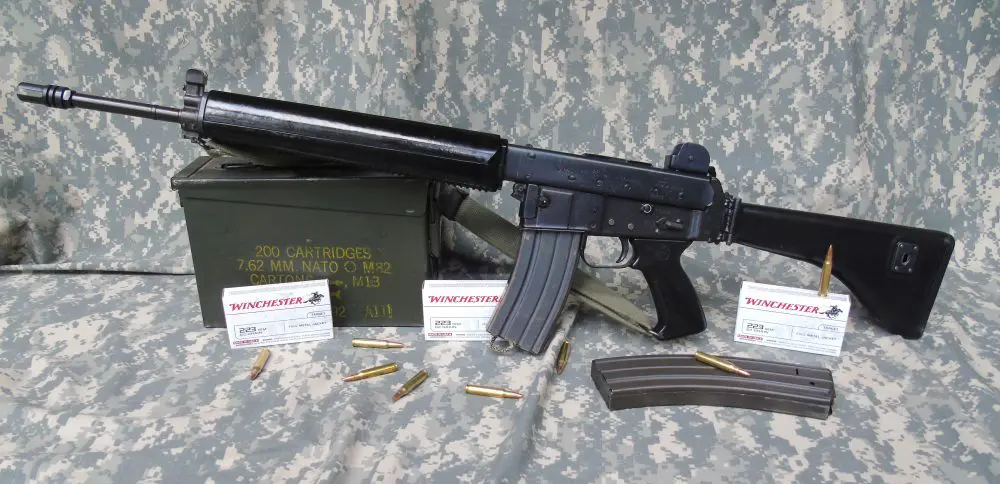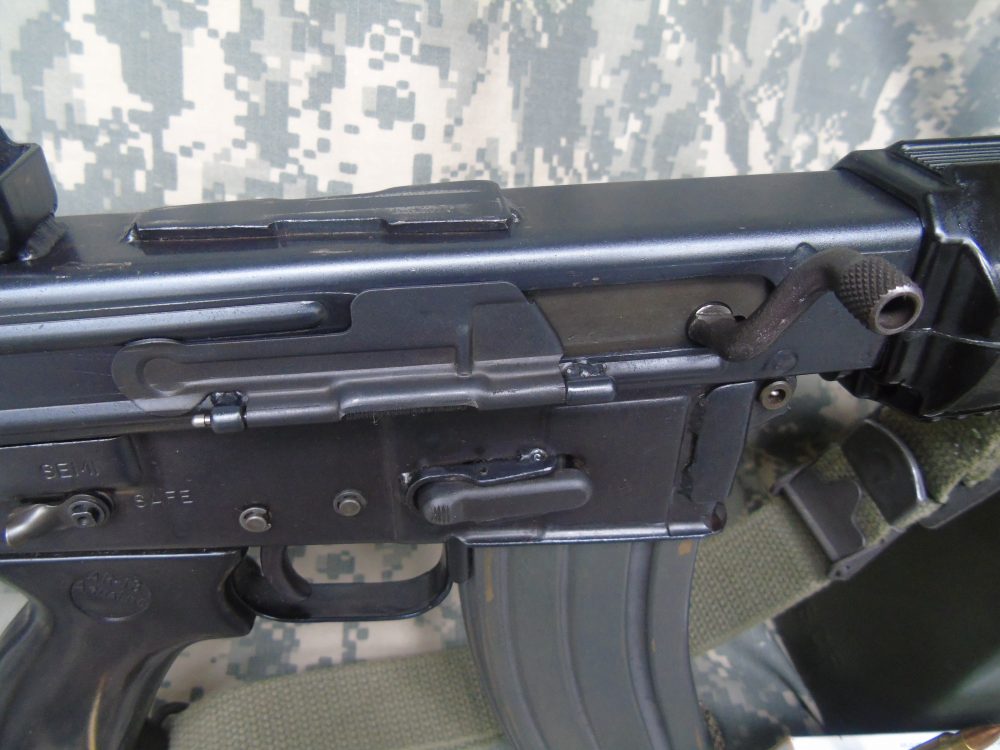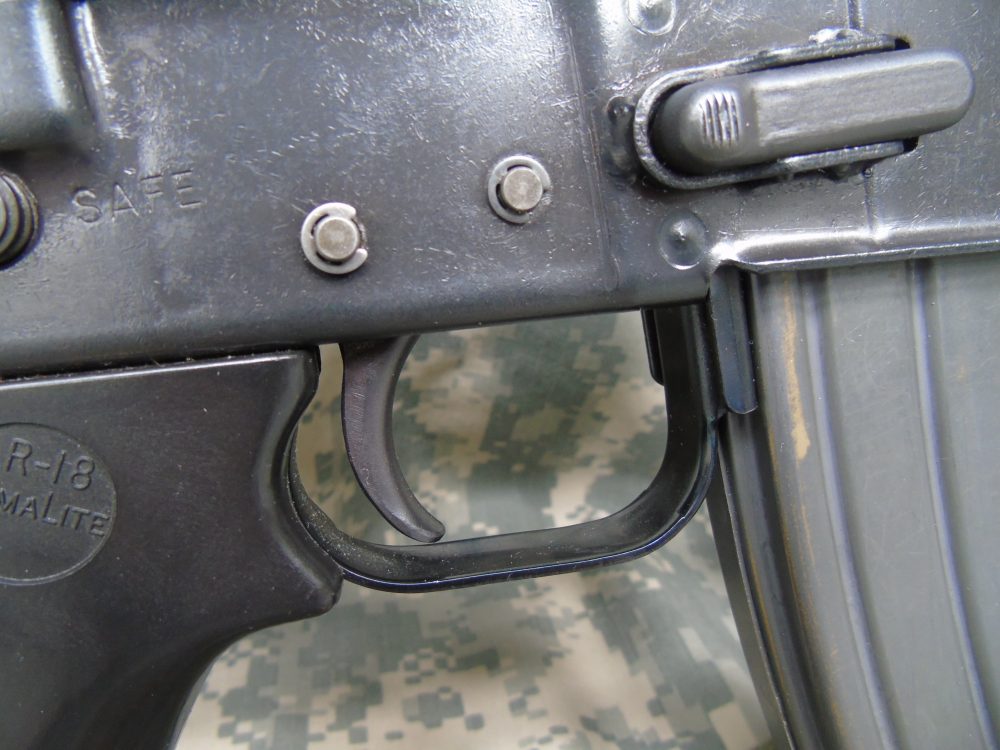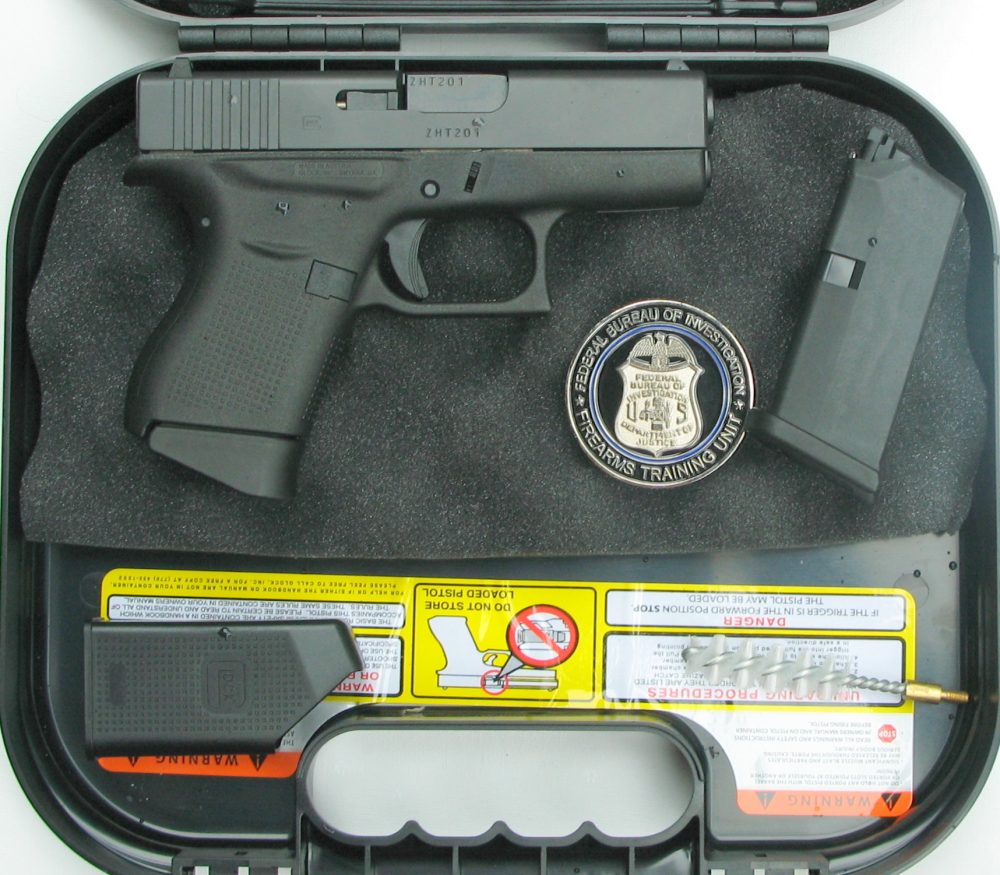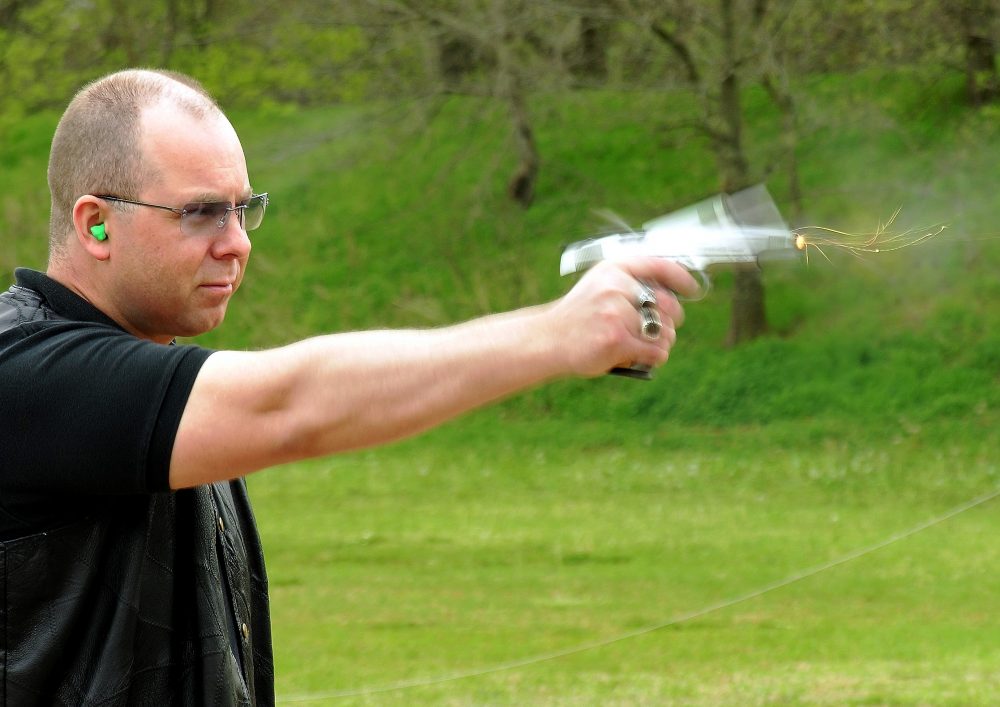ArmaLite AR-180 represents Eugene Stoner’s next generation design following up on the AR-15. Making maximal use of steel pressing technology, AR-180 was designed to be manufactured in places that lacked first-world industrial capabilities.
During a recent trip through Israel, I was struck by the suffocating influence of history on current affairs in the Middle East.
Some 4,000 years ago, the patriarch Abraham fathered two sons. The elder Ishmael was birthed by the handmaiden Hagar and went on to spawn the Arab peoples. The younger Isaac was the son of Abraham’s wife Sarah and his descendants became the Jews. Now four millennia later, the undying enmity that burns so brilliantly between these two groups stands in cacophonous testament to the timeless truism that our actions have consequences.
In the same manner that this common origin could produce such profoundly disparate cultures, a single man fathered the overwhelming majority of the free world’s small arms. Starting in the 1950s, Eugene Stoner began unconventionally applying modern manufacturing techniques adapted from the aerospace industry. In so doing, he shaped the complexion of the world’s small arms even into the Information Age.
Original AR-15 went on to become the M16. While futuristic and groundbreaking, M16 required advanced manufacturing capa-bilities to produce.
Table of Contents
IN THE BEGINNING
The origins of the AR-15 are exhaustively documented. While working for ArmaLite, a division of Fairchild Engine & Airplane Corporation, Eugene Stoner and a team of engineers designed a rifle so advanced its very ap-pearance proclaimed its uniqueness.
At a time when the world’s weapons were all forged steel and oiled walnut, the AR-10, the 7.62x51mm precursor to the AR-15, was built from aircraft aluminum and phenolic polymers. The light weight, unconventional chambering, and timeless ergonomics of the subsequent scaled-down 5.56x45mm AR-15 captured the imagination of policy makers in a way never before seen nor subsequently repeated.
As a result, despite some well-publicized initial shortcomings, the M16 went on to become the longest-serving military rifle in American history.
Like most revolutions, the design of the AR-15 had its origins in predictable spaces. The direct gas impingement system that is both hailed by skilled marksmen as exceptionally accurate and decried by critics as unreliable in combat had its genesis in the World War II-era Swedish Ljungman Automatgevär AG-42 rifle.
Spring-loaded sheet steel dust cover occludes bolt race when rifle is not in use. Firing first round pops this door open.
The machined aluminum receivers mimic aircraft components, and the polymer pieces have their origins in the synthetic Bakelite of WWII.
The 5.56mm round began as a modified .222 Remington sporting cartridge. Enhancements such as chrome-plated chambers and bores arose out of necessity exposed by hard experience. The resulting rifle, while indeed extraordinary, required an advanced production capability to manufacture.
ArmaLite was never really in the business of producing weapons. Their mission was one of research and design. The ArmaLite business model had their design team prototyping weapons and then licensing their manufacture to established production firms like Colt.
Once the AR-15 was sold and the books closed on that project, it was time to move on to something different.
Fire controls on AR-180 are bilateral. Apparently left-handed people were not invented until the late 1960s.
EVOLUTION IN ACTION
The next generation was actually called the AR-16 and it strived to remedy some of the inevitable manufacturing challenges implicit in using aerospace technology on small arms. The AR-16 looked and felt like something out of the Buck Rogers serials, but all that awesome came at a cost.
Manufacture of the rifle required advanced capabilities to produce the aluminum forgings necessary to build the receivers. This kept the market closed to smaller, less technologically advanced nations. Arthur Miller, Gene Stoner, George Sullivan, and Charles Dorchester saw this as an opportunity and designed the AR-16 accordingly.
The 7.62x51mm AR-16 took some of the basic concepts that made the AR-15 so revolutionary and adapted them to allow the rifle to be built in simpler places. Gone were the expensive aluminum receivers with their elegant geometry, now replaced by stamped steel components that could be pressed out on industrial metal presses by legions of semi-skilled workers.
Like most of the rifle, magazine release is com-prised of stamped steel component parts. Use of stampings made AR-180’s design more amenable to less-developed societies than did all the forgings and millings required of the AR-15. Hammer and trigger pins are retained by simple industrial fasteners.
While the dies required to undertake such pressings cost a holy fortune, once they are built, installed, and calibrated, they produce parts en masse at very reasonable cost. As manifest in the AR-16 design, this meant a lot of rifles could be produced in nations with only modest production capabilities and semi-literate workers.
While the AR-16 dispensed with the aluminum receivers of the AR-15, it also did away with the controversial direct gas impingement system of operation. While innately accurate and elegant, this Swedish contrivance did dump scads of fouling back into the rifle’s action and necessitated frequent cleaning and regular maintenance. By contrast, the AR-16 was designed around a more conventional short-stroke gas piston design that kept most of the grunge out forward and away from the action.
Mr. Stoner and ArmaLite parted company soon thereafter and the AR-16 took its place in history, never to go beyond the prototype stage. But the subsequent progeny, the scaled-down 5.56x45mm version of the AR-16, titled the AR-18, went on to find some serious legs.
Sights on AR-180 are typical of its era. Flip rear peep sights are easily adjustable for windage.
TRANSITIONAL FORMS AND EVOLUTION
The AR-18 and its semi-auto civilian counterpart, the AR-180, were comparably revolutionary in their own right. Stocks were made from a robust black polymer and the major components, including the fire control system, were pressed sheet steel. The rifles sported sinister flash suppressors and lightweight detachable box magazines as well as the now-familiar 5.56x45mm chambering.
Sensing a gold mine in the making, ArmaLite pushed the rifles on the international arms market. The angle was simply that underdeveloped nations could purchase the manufacturing rights and build up their own domestic supply of small arms independent of larger benefactor countries that might provide guns with strings attached. Alas, the timing just wasn’t right.
The AR-180 was built in California, Japan, and England before it spent its steam and ran its commercial course. Interestingly, the Japanese saga ended when AR-180s, called “ArmaLites” conversationally in the parlance of the era, started showing up in the troubles in Northern Ireland. When these guns were found to have been diverted for use in an active armed conflict, the Japanese ceased production and washed their hands of the design.
The sale of these rifles in the U.S. during our involvement in Vietnam was said to have caused some angst as well. The English version had the worst production quality of the three types, but all the guns ran fairly well. The design was all stamped steel and welding, and the guns could indeed be produced using fixtures and presses fairly easily.
Flash suppressor on most AR-180s is similar to open-pronged version on original AR-15. While incrementally better at elimi-nating muzzle flash when compared to a closed sort, this design was prone to catch on vines and brush. Later AR-180s offered closed birdcage de-sign.
SIBLING RIVALRY
Since you are savvy enough to be reading this magazine, you know how an AR-15 runs. I’ll spare you the rehash. But the AR-180 has its own quirky personality.
The charging handle reciprocates and serves as its own forward assist in the event of a sticky round or fouled chamber. This component has an interesting serpentine geometry to allow manipulation by either hand as appropriate. The safety selector is in the same spot as the AR-15 but is ambidextrous, an advanced notion for its day. Apparently left-handed people were not invented until the late 1960s.
Magazines are functionally identical to those of the AR-15 but are retained via a unique slot cut into the right side of the device. AR-15 mags may be successfully adapted for use in the 180 with a drill press and some careful file work. The bolt locks open on the last round fired and is released by giving the charging handle a quick snatch to the rear.
There is a spring-loaded dust cover that protects the operating slot on the right of the gun and pops open when the first round is fired. The recoil assembly is retained within the receiver so the buttstock is free to pivot around to the left to be retained in the closed position via a spring-loaded catch. Stripping procedures are straightforward enough, and the flip-up sights are similar in form and function to those of the AR-15. The AR-18 is the same rifle, only equipped with a full-auto happy switch.
Front sight on AR-180 is fenced and adjustable for elevation.
PRACTICAL TACTICAL
On the range, the two rifles have distinctive personalities. The AR-15 sports that distinctive twang as the buffer and spring cycle mere millimeters from the firer’s cheek. The AR-180 dispenses with this novel distraction. The AR-15 does indeed feel a wee bit smoother in action, but practical accuracy between these two old rifles is very similar.
The manual of arms for the AR-180 is fundamentally different from that of its AR-15 progenitor, but I am not sure that it might be an im-provement. The T-shaped charging handle of the AR-15 looks cool but has always seemed a wee bit awkward. The more utilitarian exposed steel han-dle on the 180 loses a few cool points but is simpler and easier to run tacti-cally.
Magazine changes are comparable, and both guns weigh about the same. The slick plastic furniture is similarly slippery between the de-signs, and muzzle flash is about the same after dark. Slings on both guns at-tach on the bottom in the exact wrong spot for tactical applications, though the open front sight base on the AR-15 does offer a few more mounting op-tions.
AR-180 magazines are identical to their more fa-miliar AR-15 counterparts save a small retention slot on the right side. AR-15 mags may be converted with some careful drilling and file work while still remaining usable in both rifles.
GENERATIONS
The AR-180 was rumored to be a bit frail for general military use, though the IRA revolutionaries who wielded them bragged on the guns. The truly fascinating piece of the story rests in where the design went after the AR-180 died of natural causes. The basic Stoner-inspired short-stroke piston-driven operating system subsequently showed up in some of the most unexpected places.
The extraordinary Austrian Steyr AUG used a heavily modified version of this system, while the British SA80/L85 bullpup and German HK G36 copied the basic design almost completely.
Later designs like the FN SCAR and Beretta ARX-160 were clearly influenced by the short-stroke system, and components of the system can be found on guns of varying notoriety around the globe.
Recoil spring on the AR-180 is contained within the upper receiver assembly. This allows the rifle to incorporate a side-folding stock that makes it quite compact.
Enterprising designers have even made a proper splash by melding the remarkable ergonomics of the AR-15 with the cleaner system of the AR-180 to produce some truly extraordinary hybrids. The HK 416 that sent Osama bin Laden to his gory end is a perfect example.
At times, some of the most remarkable products spring from a common foundation. While the far-sighted observer will appreciate that Jews and Arabs are all brothers in a geopolitical sense, similarly the M16, G36, AUG, SA80, SCAR, ARX, and scads of other designs all sprang from the fertile mind of Eugene Stoner.
Despite the inevitable rivalry that arises from all fraternal relationships, these two disparate small arms, the AR-15 and AR-180, remain complementary stepbrothers in the purest sense.
